Greetings,
The Oak Tree
PT Newsletter presents information that is in some way related
to physical therapy and health- related issues. We hope that you
find it interesting, informative, topical, and timely.
We would like your feedback on any of the topics presented here,
and on any topics that you would like to see addressed in the
future. Please feel free to send in questions that are relevant to
our focus, and we will try to answer as many as we can in our
"Readers' Forum"
| BACK TO BED |
 |
 Low back pain (LBP) drives some people to take extreme
measures. From slipping thick plywood boards between their
extra-firm mattress and the box spring, to sleeping on the
floor, those with back problems have endured all types of
discomforts in the belief that firm surfaces provide the best
relief from back pain. Low back pain (LBP) drives some people to take extreme
measures. From slipping thick plywood boards between their
extra-firm mattress and the box spring, to sleeping on the
floor, those with back problems have endured all types of
discomforts in the belief that firm surfaces provide the best
relief from back pain.
Research published in The Lancet debunks this myth. The
study involved 313 people with insidious onset of LBP that
they experienced while lying in bed or upon getting up in the
morning. Half the subjects participating in the study slept on
firm mattresses (rated 2.5/10) and half slept on mediums
(rated 5.6/10), with one being the firmest and 10 the softest
on the scale.
The subjects recorded their LBP on a one to 10 scale before
receiving the new mattresses, and then again after sleeping on
them for three months. They also measured changes in
pain-related disability.
About 82% of those on the
medium mattresses said they improved, compared with 68% of the
people who had slept on firm mattressess.
The authors
of the study believe that the results were skewed against the
medium mattresses. They say that people knew whether or not
they had been given a firm mattress, and most people believe
that a firm mattress is better for LBP. Because of this known
bias, the scientists conjecture that medium mattresses are
even better for LBP sufferers than the already impressive
results suggest.
While Goldilocks figured it out intuitively, she probably
did not understand why the medium bed was "just right" for
her. A soft bed does not provide enough support for the spine
and muscles, while a firm mattress causes pressure points to
develop. The medium mattress provides an equal distribution of
support across the whole body surface that comes in contact
with the bed.
View
Abstract... »
|
| AGING IN PLACE |
 |
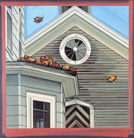 According to a recent AARP housing survey, 83 percent of older
Americans want to stay in their current homes for the rest of
their lives. They find their homes comfortable and convenient
and feel secure and independent there. Survey responders said
that they would prefer to remain in their homes even if they
needed assistance with their basic activities of daily living
(ADL's). According to a recent AARP housing survey, 83 percent of older
Americans want to stay in their current homes for the rest of
their lives. They find their homes comfortable and convenient
and feel secure and independent there. Survey responders said
that they would prefer to remain in their homes even if they
needed assistance with their basic activities of daily living
(ADL's).
 However, as people age, the design of their homes
plays an increasingly important role in how they manage their
daily activities. Homes that were perfectly convenient at age
55 can cause problems in later years, as diminishing physical
abilities make daily routines more difficult without some
design modifications. However, as people age, the design of their homes
plays an increasingly important role in how they manage their
daily activities. Homes that were perfectly convenient at age
55 can cause problems in later years, as diminishing physical
abilities make daily routines more difficult without some
design modifications.
People often find that they can
no longer make it up the stairs, and there is no bedroom or
bathroom on the first floor. There may be no railing at the
front steps. The inside doorways are often too narrow to
accommodate a walker or a wheelchair. Many people find they
are unable to get up off the toilet once they sit down because
it is too low, or that they can not safely get in and out of
the tub or shower.
Experts in the health, homebuilding,
and retirement- planning fields recommend that younger people
should plan their homes for their retirement years just as
they plan their finances and a number of other important
considerations.
 As one remodeling contractor quoted in BusinessWeek online says, "When
you're framing out a bathroom, it's a simple process to
reinforce the walls so that grab bars could be mounted to a
solid structure. It takes a $20 to $30 piece of hardware, and
maybe 15 minutes of a carpenter's time." But if you don't
think ahead and decide later that you want grab bars, he says,
removing tile and plaster and then doing the reinforcement
"could take a half a day or more," and be much more expensive.
So the best time to do these projects is when the house is
first being built, or during already planned
renovations. As one remodeling contractor quoted in BusinessWeek online says, "When
you're framing out a bathroom, it's a simple process to
reinforce the walls so that grab bars could be mounted to a
solid structure. It takes a $20 to $30 piece of hardware, and
maybe 15 minutes of a carpenter's time." But if you don't
think ahead and decide later that you want grab bars, he says,
removing tile and plaster and then doing the reinforcement
"could take a half a day or more," and be much more expensive.
So the best time to do these projects is when the house is
first being built, or during already planned
renovations.
 Take a good look at your home. Simple alterations
can prevent one-third of all home accidents. These changes not
only increase your safety, but enhance your comfort and
increase the likelihood of your remaining independent in your
home and community. Take a good look at your home. Simple alterations
can prevent one-third of all home accidents. These changes not
only increase your safety, but enhance your comfort and
increase the likelihood of your remaining independent in your
home and community.
THE FOLLOWING WEBSITES CONTAIN VALUABLE INFORMATION
ABOUT AGING IN PLACE INITIATIVES AND UNIVERSAL HOME
DESIGN:
(If you have trouble reaching any of the links,
press "Ctrl" and click on the link at the same
time.)
National Center for Seniors' Housing
Research
Concrete Change
Senior Safe Home
LifeEase
LifeEase Practical Guide to Universal Home
Design PDF
AARP
Universal Home
Guidelines
|
| HEALTH & FITNESS QUICK-TAKES |
 |
 For decades, doctors have recommended ipecac
syrup to induce vomiting in children who have ingested
poisonous substances. This derivative from the root of the
tropical ipecac plant has been one of the necessities for a
well-stocked first aid kit. For decades, doctors have recommended ipecac
syrup to induce vomiting in children who have ingested
poisonous substances. This derivative from the root of the
tropical ipecac plant has been one of the necessities for a
well-stocked first aid kit.
However, the American Academy of
Pediatrics (AAP) is now discouraging the use of ipecac,
and the U.S. Food and Drug Administration (FDA) may end
over-the- counter sales of the drug as early as next year.
According to the AAP, many people use the syrup
inappropriately, without consulting a doctor or a poison
control center. They say that ipecac can cause  symptoms which are similar to an overdose of
sedatives, complicating the proper diagnosis and treatment of
the child. Furthermore, ipecac does not work completely; it
usually leaves residual poison in the stomach. It may also
stay in the body too long, causing a child to vomit up other
antidotes administered by health-care personnel. One study
found that using ipecac does not improve medical outcomes. symptoms which are similar to an overdose of
sedatives, complicating the proper diagnosis and treatment of
the child. Furthermore, ipecac does not work completely; it
usually leaves residual poison in the stomach. It may also
stay in the body too long, causing a child to vomit up other
antidotes administered by health-care personnel. One study
found that using ipecac does not improve medical outcomes.
This American Academy of Pediatrics Policy Statement: Poison Treatment in the
Home is a meta-analysis that also discusses the
difficulties of using charcoal in the home as a poison
antidote.
The November 2003 Pediatrics contains
several articles discussing the new AAP stand on ipecac.
 
DID YOU KNOW?
PRIVACY ALERT:
Google now provides reverse listings on phone numbers. Typing
a phone number into the Google search window will elicit the
owner's name, address, and Map Quest directions to the address
of record for that number.
Private information may be
removed from the Google reverse listings by clicking on the
telephone icon next to the phone number when the listing comes
up in the search results, but Google takes 48 hours to process
the removal. Unlisted phone numbers may or may not be in the
Google database, so if having this information listed is a
concern, it is a good idea to check. Go to http://www.google.com, type the telephone
number into the search box, and hit "Enter".
Many other
sites also provide reverse listings, and removing the
information from Google does not remove it from the other
databases. On their page that details how to remove the
private information, Google provides a partial list of the
other databases, and they recommend performing a web search
for a more complete list.
THE GREAT AMERICAN SMOKEOUT IS NOVEMBER 20,
2003
(It is always the third Thursday in
November)
FOLLOW THESE LINKS FOR ACTIVITIES, IDEAS,
AIDS, AND OTHER VALUABLE INFORMATION RELATED TO QUITTING
SMOKING:
American Cancer Society
TobaccoFree.org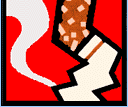
Telephone Quitlines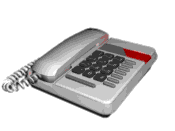
Rotator cuff tears are
common, painful, and they can be debilitating. Depending on
the extent of the tear, they often respond well to Physical
Therapy. Sometimes therapy is not enough, and then the injury
requires surgical repair. But what happens when the
musculotendinous unit is too far gone, making it impossible to
repair the tear?
 In the case of the subscapularis tendon, research
published in the October 1, 2003 American edition of the Journal of Bone and Joint Surgery
found that transferring the pectoralis major tendon worked
pretty well in substituting for lost subscapularis function,
even when there was an associated irreparable supraspinatus
tear. However, the results were less favorable when the
supraspinatus tendon was also involved, and surgeons may be
less willing to perform the pectoralis major tendon transfer
in those cases. In the case of the subscapularis tendon, research
published in the October 1, 2003 American edition of the Journal of Bone and Joint Surgery
found that transferring the pectoralis major tendon worked
pretty well in substituting for lost subscapularis function,
even when there was an associated irreparable supraspinatus
tear. However, the results were less favorable when the
supraspinatus tendon was also involved, and surgeons may be
less willing to perform the pectoralis major tendon transfer
in those cases.
Swiss Balls have long
been used in the clinic to successfully train and reeducate
postural muscles, improving their control. Now, a growing
number of people are using these exercise balls as office
furniture, replacing their desk chairs.
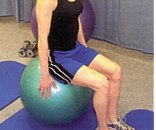 Physical Therapists should caution people to build
up their sitting time on the balls slowly. The postural
muscles are very susceptible to fatigability, so sitting on
the physioballs for eight to 12 hours at a time is not a good
idea. Sitting for 20 to 30 minutes at a time is a good
starting point for someone who is at a reasonable level of
fitness, and that time can be increased slowly. However,
sitting on the ball throughout the whole workday should not be
the end goal in any case. Physical Therapists should caution people to build
up their sitting time on the balls slowly. The postural
muscles are very susceptible to fatigability, so sitting on
the physioballs for eight to 12 hours at a time is not a good
idea. Sitting for 20 to 30 minutes at a time is a good
starting point for someone who is at a reasonable level of
fitness, and that time can be increased slowly. However,
sitting on the ball throughout the whole workday should not be
the end goal in any case.
|
| READERS' FORUM |
 |
 This spot features answers to questions from our
readers. Send your physical therapy-related questions to: pt@oaktreept.com. This spot features answers to questions from our
readers. Send your physical therapy-related questions to: pt@oaktreept.com.
If we answer your question in this column, we will
send you an Oak Tree PT ergonomic pen. Please be sure to
include your mailing address, to be used strictly for mailing
the pen only, and no other purpose.
I will also be
happy to publish in this Readers' Forum any original,
relevant, well-written articles submitted by readers. Just
forward your material to:
pt@oaktreept.com.
I ASKED THE FOLLOWING QUESTION IN OCTOBER'S
ISSUE:
What is the physiological cause of the dark
circles people get under their eyes when they go for prolonged
periods with little or no sleep?
PENNY GERSHMAN
WROTE BACK TO ME IMMEDIATELY (She says she is very
competitive) WITH THIS ANSWER:
Here is what I found
about the dark circles: from: http://www.abc.net.au/science/k2/h
omework/s95516.htm
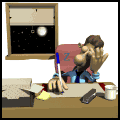 "First, the blood supply from that skin drains into
the internal jugular vein. That drainage is a lot better when
you're lying down than when you're standing up - so the blood
tends to pool there. This is one factor that will give you
dark half-circles under the eyes. "First, the blood supply from that skin drains into
the internal jugular vein. That drainage is a lot better when
you're lying down than when you're standing up - so the blood
tends to pool there. This is one factor that will give you
dark half-circles under the eyes.
Second, you have huge
numbers of Mast Cells in the skin under the eyes. These Mast
Cells will release histamine (sometimes by themselves, and
sometimes when you rub them), which will cause swelling under
the eyes - and darkness.
Third, when you get dehydrated
(which sometimes happens when you get tired), the skin under
the eyes gets dark. And finally, not a reason but an
observation. Eyes in animals are an important signalling area.
"
-Peninah
(Editor's note: The website goes on to
say that this phenomenon therefore signals to other humans
that we are tired.)
An Oak Tree PT
ergonomic pen was pony expressed to Penny for her enterprising
answer to my question.
| |
|

